
What's in your Pockets
Always an interesting question... Ask any Firefighter what's in the pockets of their gear, and why. Everyone has different ideas, and there is typically an interesting explanation. Email in your ideas, and or pictures an we'll list them here.
Webbing Storage
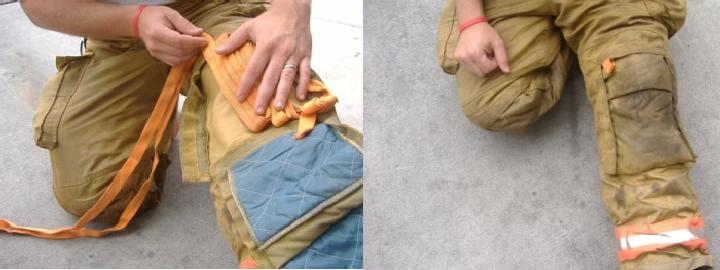
Webbing is an amazing tool for the fireground. Every firefighter should carry at least one 20 foot section. Check out some of the other tips that demonstrate the multiple uses of webbing. Even though it's not technically in your pocket, a good place to store a loop of webbing is in the removable kneepad in your bunker pants, it's easy to get to and really doesn't get in the way. This idea was first featured in the Tips from the Bucket section.
Modified Channel Lock Pliers
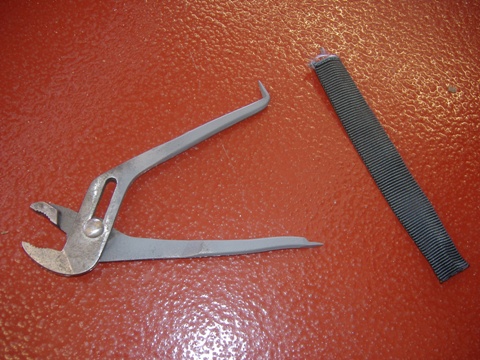
A pair of channel locks are always handy to have. They serve multiple purposes, and are even useful for removing battery cables on vehicles. Simply grab onto the battery connection and twist back and forth, it typically comes off pretty easy.
The pair above have been modified to be used as a key tool. One end was placed on the grinder to be used to manipulate a lock when using the through the lock method of entry. The other end was heated, bent, then ground down to be used as 90 degree lock tool. The webbing pictured is placed over the sharpened ends to prevent self inflicted trauma when stored in your pocket.
Tool Wrap
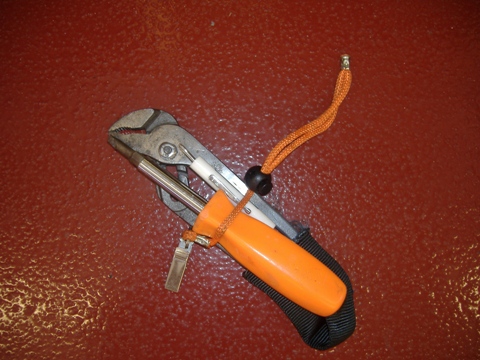
It's sometimes helpful to bind all of the tools in your pocket together, it keeps them from poking multiple holes in your leg! A Velcro strap wrapped around the tools is a great option, unfortunately I just lost mine so this sorry looking strap will have to do for now. When using a Velcro strap be sure to tape one end to make it easier to open with a gloved hand.
The modified channel lock is shown here with the protective webbing in place. Also pictured is the very handy 5 in 1 screwdriver. It has two different flat tips, two phillips tips, and a hex drive that works when disassembling most air handler units.
Like I said before there is typically a story behind what each person carries. The small white screwdriver pictured is used to reset fire alarm pull stations. I have "heard" that using a knife instead of a screwdriver may be a bad idea, it could lead to attempted finger amputation!
Tool Bag
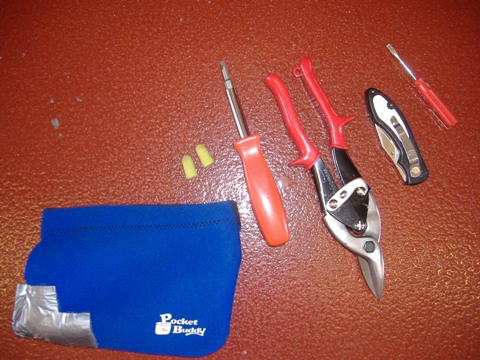
Firefighter Blakely Vasen from Winter Park Truck 61 uses this handy "tool bag" to confine items placed in his pocket. Tin snips are an extremely beneficial tool to carry, they cut through electrical wire, and other wires that you can get wrapped up in during a fire (ceiling grid suspension wire, HVAC coil wire, etc.) The custom duct tape job is to prevent the tin snips from poking through.
By the way, that is the actual knife that taught me the important lesson to carry the miniature screw driver. Notice Blakely now carries mini screw driver also. Thanks Bro!
Shove Knife and Elevator Key
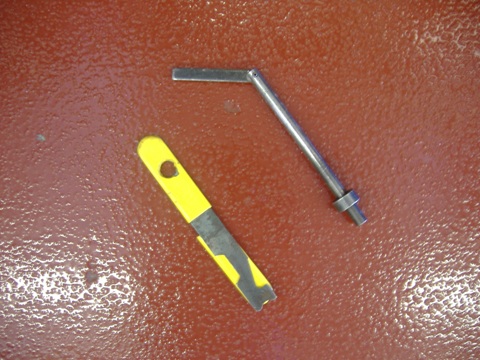
Both of these tools are great to have. They are light, take up very little room, and are used frequently.
Tin Snips and Backup Light
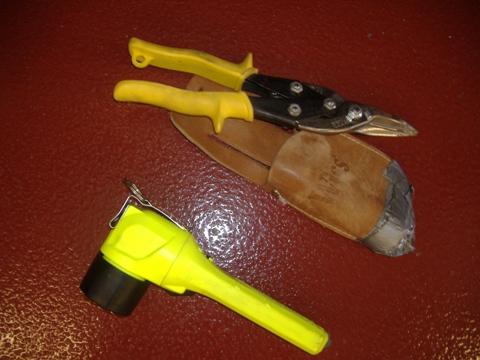
As mentioned above, Tin Snips are extremely versatile. The importance of a backup light in your pocket should not be underestimated. The one picture in a Pelican "Little Ed", it seems to work well.
Ear Plugs stored in your Lid
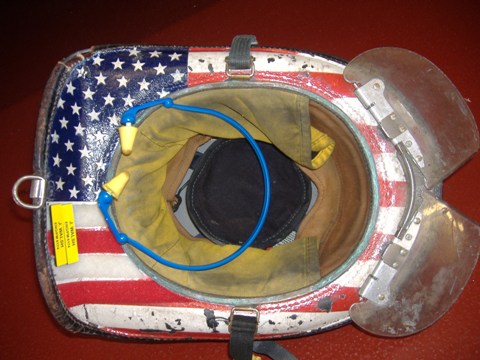
Lieutenant Rich Taylor from Winter Park Truck 61 showed me this great idea. Ear plugs are great to have but frequently get damaged or lost. The plugs pictured above are stored inside my lid in-between the helmet and suspension webbing. They bend pretty easily and stay out of the way.
The idea for the sweet paint job was stolen from Lieutenant Walt Lewis from Orlando Fire Department. Apparently Walt stole it from Joey Alverez from Maplewood (NJ) Fire Dept.
Handy (and cheap!) Door Chock
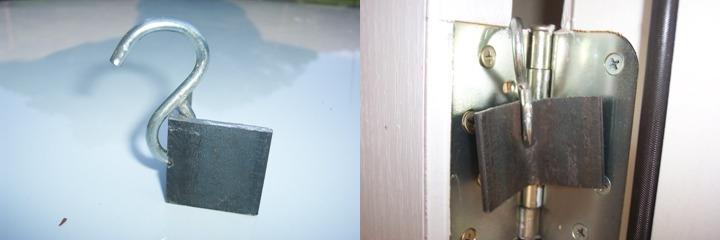
Jason Jefferies from Charlotte Engine 37 sent in this simple and cheap door chock. He was quick to point out that he didn't invent this himself, but we're giving him credit for it anyway! All you need is a piece of 1" or 2" angle iron and an "S" hook.
Drill a 3/16" in the center of the angle iron and insert one end of the "S" hook. Take a pair of pliers and bend the hook so that it closes (pictured on left.) It's as simple as that!
When you use the door chock, simply hang it on the hinge of the door you need to keep open. The beauty of this type of door chock is that it is out of the way and will not be effected by an advancing hoseline or accidentally kicked out of the way.
I would recommend painting your chocks with fluorescent paint for visibility and identification. I can see in now, someone trashing the door because they were trying to force it closed with the chock in place...
Cherry Bombers
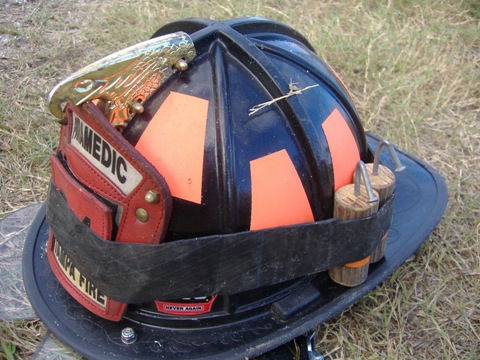
Alright so maybe it's not really in your pockets, but it could be! One of the brothers from Tampa Fire shared this great idea. They are called "Cherry Bombers." They are made from a wood dowel and a bent nail. They can be placed over a door hinge to keep the door open. Cheap and effective!
Originally we weren't sure who came up with this great idea. Thankfully Tony Perez from Tampa fire gave us the heads up on who deserves credit for this one. Wayne Tolzman from Tampa Firehouse 5 is now formally credited as the originator of this "tip." Thanks fellas!
Rescue Shears & Rescue Hammer
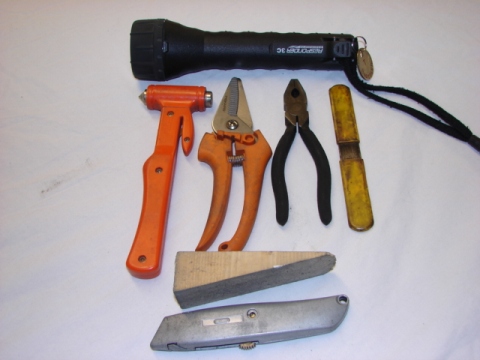
Tim Brozoskie from Baltimore City Rescue Co 1, sent in some things we haven't featured yet.
The simple utility knife, always sharp, if it gets dull just change a blade, if you loose it, only $3
Gerber rescue shears, they are spring loaded , so they operate easy in 1 hand. If you get hung up, you can reach behind you and start snipping, they can cut clothing, seatbelts, SCBA harness, rope, household cables, and are excellent for the wire harnesses found on car doors.
"Rescue hammer" unlike spring loaded punches, this always works, has a seatbelt blade, and in a pinch it can smash household glass.
Linesman pliers, work well on suspended ceiling wire.
Is that a Cigar in your Pocket?
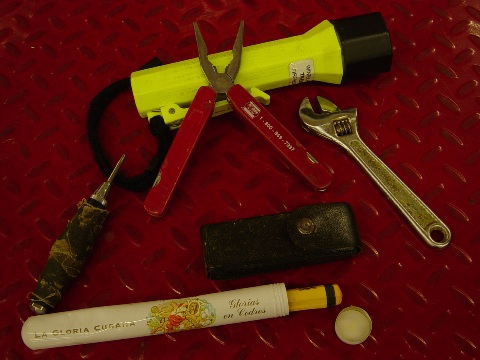
Lt. AJ Isaacs from Winter Park Firehouse 61 had a few more.
Cheap throw-down multi tool. (It sucks when you loose a good one.)
Crescent wrench has many different uses including: disconnecting a battery, opening an HVAC, or shutting off a valve.
A center punch. Wrapped with tape for ease of use with a gloved hand, and helps retain it in your pocket.
A yellow crayon. This is good for marking doors during a search. The cigar tube keeps it from getting crushed in your pocket.
It's Cold Out
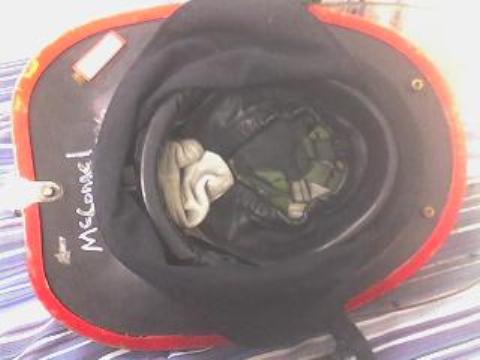
Hunter McConnel from North Star Fire Department in Interior Alaska sent in this idea. It's not really in his pocket, but we'll consider it good enough for this page. He told us that a lot of the brothers from frigid Alaska do this, and that he didn't "invent it." We'll you know the rules, if your the first to send it to us, you get the credit. He advised that they carry two of almost everything because it is so cold and when you or your buddy forgets your hood you have an extra one right above your head. It's definitely not something that would ever be a problem in Florida, but it sounds good enough to us.
Putty Knife
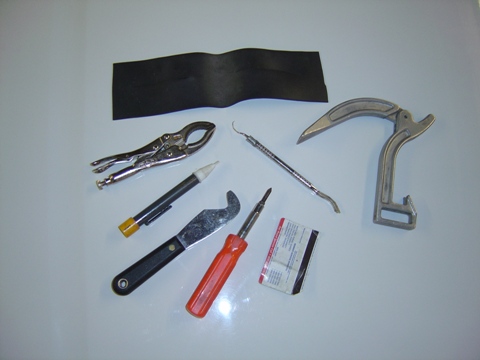
Here's what Lieutanant Eric Norberg from West Warwick Rhode Island Fire Department carries in his pockets. He points out that it may seem like a lot of extra "stuff" and added weight, but he's willing to carry the extra pound or two to make his job easier.
He uses a home made shove knife, ground down from a putty knife. It has a nice handle and the spring steel it is very flexible. A pair of vise grips that are designed to go around circular objects, like lock cylinders, pipe, etc. A standard credit card for slipping past a knob and key lock on inward swinging doors. A 6 in 1 screw driver, not only does it have large and small slotted and phillips heads, it also has two hex heads that fit most HVAC units or duct work. A rubber door strap, it is a simple piece of inner tube tire with two slots in it to slip over each side of a door handle. It prevents self closing doors from latching behind you. A electrical current tester, just plug it into an outlet or hold it near a suspected live wire to confirm its status. A spanner wrench with multiple uses including, a gas shut off, small pry end, and standard and stortz connections. Lastly, a dental pick for tripping any intricate door latching mechanism, or any other small detailed thing.
Another Door Chock
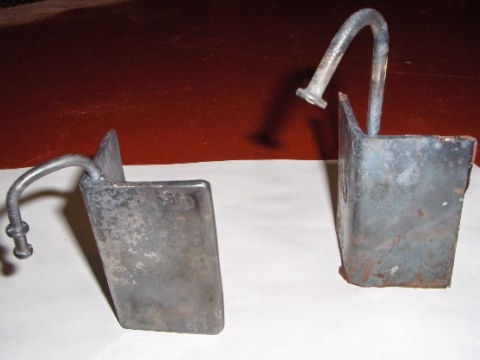
Lt. Jason Rivera Rescue Co. 1 Stamford, CT Fire Rescue Dept. sent in this variation of the angle iron door chock. Its a piece of angle iron with a nail welded to the inside angle. The nail is then heated up with an oxy/acetylene torch and bent over so it will hang on the doors hinges. They may not be pretty, but they take about 5-10 minutes to make and are a lot cheaper then the store bought brands. If you forget one after a run, no problem just go make another, its also a good training opportunity to use the oxy/acetylene torch.
Nail Wedges
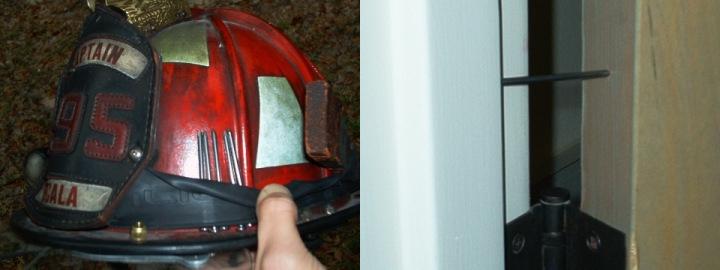
A bunch of readers have sent in the idea of using nails as wedges, but Captain Mike Alsup from Ocala Fire Dept was the first to include a photo. Besides carrying "regular" wedges he carries 8 penny nails in the strap of his helmet. They are lightweight and out of the way. Open the door, place the nail in between the door and the jamb, and "set" them by pulling the door shut just a bit. He also points out that with this size, you can still slam the door shut if things go bad.
Masonry cut nails also work very well. When using this method on a metal door and frame, simply open the door, place the nail in the screw heads of the hinges, and the door closer does the rest.
Which Pocket is it Anyway?
Firefighter Mitch Sanders from Orlando Tower 11 send in a real simple idea about keeping stuff in your pockets...Which pocket is it in? He mentions how it drives him crazy digging thru his pockets looking for that tool that is needed RIGHT NOW! He suggests organizing your pockets like the compartments on the rigs. He has an extrication pocket (valve stem tool, center punch, etc), search pocket (chocks, nails, small search rope, etc) and tool pocket (screwdriver, wire cutters, etc) He points out how we go to great lengths to organize our rigs so that our tools are stored for EFFICIENCY, and why should our personal tool should be any different?
Wedge Storage
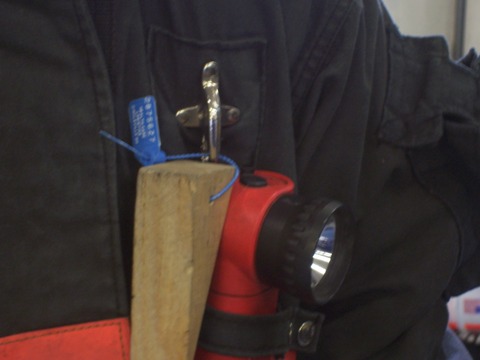
Firefighter Ryan Marzheuser from Sycamore Township Ohio sent in this photo of another way to conveniently store a door wedge. Simply drill a hole into wedge and loop an EMS or fire extinguisher tag through the hole. (See, we knew EMS has a its place on a truck company!) This allows this loop to be clipped onto your bunker coat. You could really use the tag to secure the wedge almost anywhere. Just pull on the wedge to place it in service. The beauty of this method is that it is truly a break away set-up, it will free itself if it gets hung up on anything.
Tool Sleeve
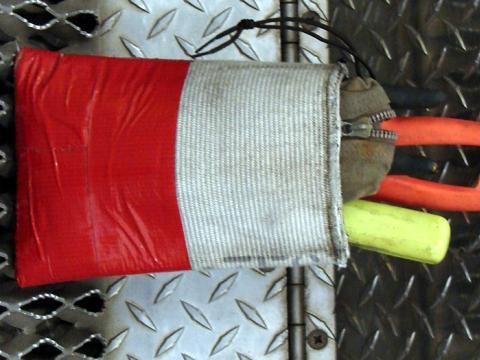
Lt. Tim Biermann from Baltimore City Rescue 1 sent in this great idea to keep your pockets organized. This tool sleeve is fashioned from a scrap piece of 3" supply line and sealed off with some duct tape. He pointed out that it keeps your tools together and upright for easy access and removal. It also prevents your tools from poking through your pockets, and jabbing you in the leg. He also gets credit from being the first person to come up with a good use for hose on a Truck Company... :)
Flashlight Wrap
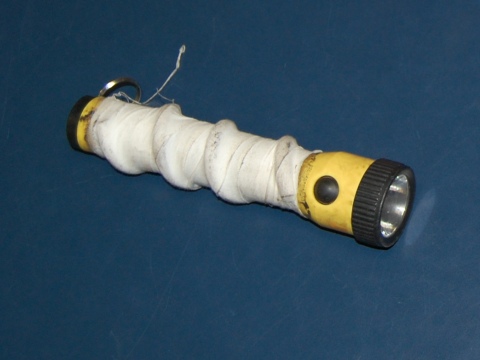
Lieutenant Walt Lewis from Orlando Fire Sent in this idea of wrapping your backup
flashlight. At first glance you may not understand the need for a flashlight wrap,
but read on, this one makes perfect sense.
A backup flashlight that is simple to use with a gloved hand is vital on the fireground. An idea he picked up
from a previous partner (Eng Mike Horn, may he rest in peace) is to wrap
the handle of the flashlight like you would a halligan. One step better,
is to have the oxygen tubing end at the push button to activate the light,
so that in a hurry, with gloves on, and in the dark, you can find the switch and get your light going.
Lieutenant Lewis sent in some additional thoughts about flashlight use on the fireground.
Be sure to check out the supplemental page for additional information.
Pruning Saw
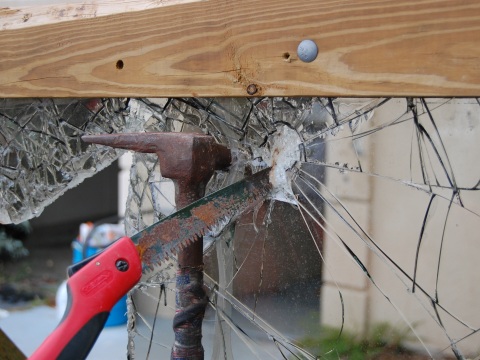
Lt. Pat Gallagher from Martin County Fire has an interesting idea
for hurricane windows. He has found that a pruning saw makes quick work on them,
and caries a small folding saw in his pocket for that purpose.
He has noticed a significant increase in the popularity of hurricane windows in his coastal area
of Florida. For obvious reasons hurricane windows don't break like traditional windows.
They are laminated, and designed to remain in place even after taking a
significant impact. He has found that using a halligan to create a purchase
point and using the saw to be quite effective. Once the purchase is made, the
saw can be used to "clear" the window. This method works well if a
window needs to be opened in a hurry, without having the proper equipment
readily available.
A saw would be the tool of choice if multiple windows need
to be opened. Obviously the preferred method would still be to take the entire
frame out, and the glass shouldn't be too much of an issue. Another interesting
observation about hurricane windows is that they tend to be mounted flush
regardless of the type of building construction being used. The old trick of
flush mount = wood frame, and recessed (with sill) = block or masonry may not
be as much of a tell tale sign as it used to be.
Bungee Cord
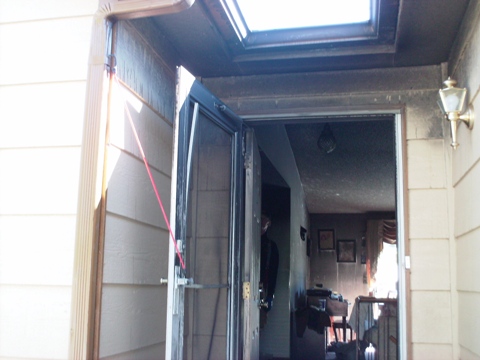
Samuel Hittle from Wichita Firehouse 10 sent in an idea that another brother from Wichita shared with him. Firefighter Tom Dent from Firehouse 9 showed him a solution utilizing a bungee cord carried in his pocket, the bungee cord is used to quickly and easily secure these doors. The boys from Firehouse 10 liked the idea so much they attached an 18” bungee to the irons. Having it attached to the irons makes it readily available for any firefighter assigned to the door position. When an attachment point cannot be found on the structure, they simply create a purchase (to hook into) on the structure by driving the halligan into the house or porch wall.
Tool Bag
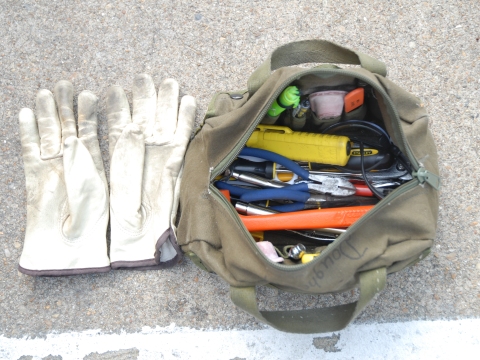
Lieutenant Brad Dougherty from Navy Region Mid-Atlantic Fire & Emergency Services sent in the latest what’s in your pockets. The irony is that his submission is about what’s not in his pockets. He took an old army ammo bag and placed some of the items that firefighters typically carry in their pockets. The bag has a large interior compartment which has some organization slots on the inside. It also has exterior compartments for other items. These compartments allow the bag to be organized without being too cluttered. He uses the bag to eliminate the excess weight in his pockets. While responding to an alarm, he reaches into the bag to retrieve what he may need on that particular alarm. He even pointed out that he has taken the whole bag on a few special occasions.
Door Clamps
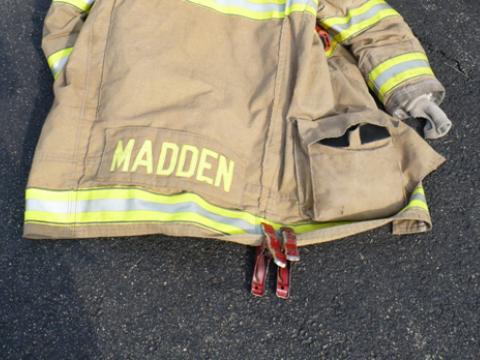
Sgt. Scott Madden from Loudoun County (VA) sent in an idea he got from one of his brothers at Station 6. The idea is to use a small spring hand clamp to wedge doors open. Scott points out that the clamps work well in a number of different ways, and on various types of doors. The photos below show a few of the many options.
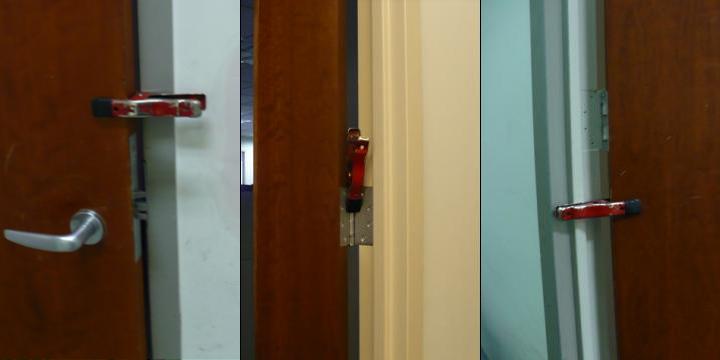
The photo to the left shows the clamp keeping a self-locking door from closing on itself. This would work well if the door needed to be controlled, while preventing it from re-locking. The photo in the middle shows the clamp being used on a hinge to prevent the door from closing. The photo on the right shows the clamp on the door itself (on the hinge side) to keep the door open.
Vise Grip Eye Bolt
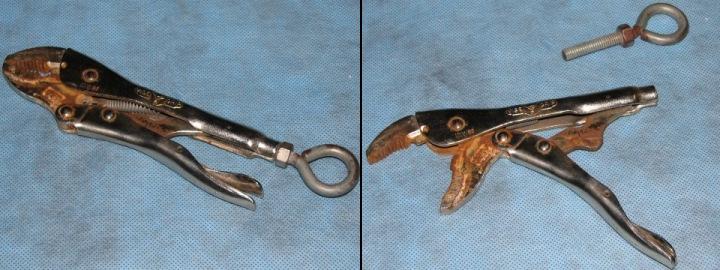
Vise grips are a great tool to have in your pocket. There are many great uses for the tool. Firefighter Sam Russell form Capital City (AK) sent in this useful modification to a pair of vise grips. Take a quick trip to the hardware store and find an eye bolt and nut that fit in place of the adjustment screw on the vise grips.
This modification is two fold, first it makes adjusting the vise grips much easier since you have the eye of the bolt to use for leverage when moving the adjustment screw. Second (and more importantly) the eye bolt gives you an attachment point for a carabineer. The attachment point is useful when using carabineer with webbing or rope on the tool to secure a padlock or chain during rotary saw forcible entry.
Flashlight Mount
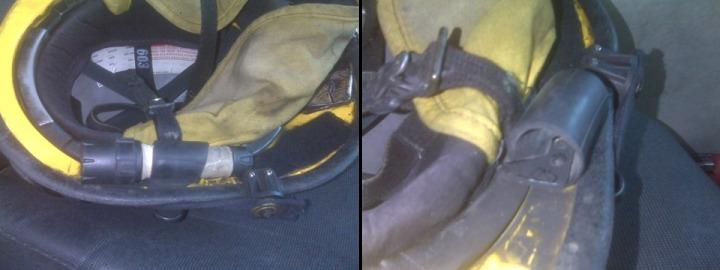
Jeff Daniels from Goodyear (AZ) Fire sent in a different method of securing a flashlight to your lid. This idea simply takes a thorn resistant bicycle tube and attaches it under the brim of the helmet. The thorn resistant tube is thicker than a standard tube and holds up better to the abuse. The tube expands to fit various size flashlights, and keeps them in place pretty effectively. Some people prefer to have the light mounted under the brim of the helmet to minimize a possible entanglement hazard. As you can see from the close-up picture the tube was secured using the shell retaining screws. Obviously this set-up will not work on all types of helmets, but it is a lightweight, cheap and effective way to secure your light if works on your style lid.
The thorn resistant bicycle tube could be used above the helmet as well. For those who have the large inter-tube that runs all the way around the helmet, the smaller thorn resistant tube could be zip tied to the larger helmet band to achieve similar results. This set-up would allow the allow this style of flashlight to be attached without using a “hard mount” bracket.
Vise Grip Clamp
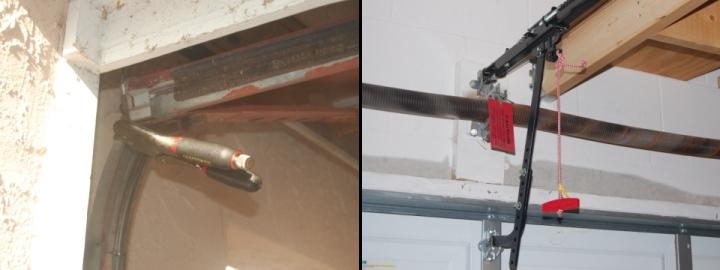
Vise grips are a versatile tool for a number of different reasons. One of their many uses is to clamp a garage door open. When working in or around a garage it’s easy to open and keep open even after utilities have already been secured. From the inside, simply reach up and activate the emergency release mechanism, which frees the door from the automatic door opener (shown in the photo below.) Once the door is open, simply take the vise grips and clamp on the track to prevent to door from closing.
The door is much “safer” once it has been released from the door opener mechanism and clamped open. The automatic garage door opener no longer has an effect on the door. This was one of the speculations in a video we posted a few years ago, that radio interference caused the garage door opener to activate and close the door. (Which would not have happened if utilities were secured.) Another reason why the door is safer is because if heat builds up in the garage around the springs this will not cause the door to close since the track is blocked by the vise grips. (make sure the vise grips are clamped tight) The springs are normally located on the front wall above the door, or along side of the tracks. If heat builds up in this area, it could cause the springs to anneal, lose tension, and lower the door. The weakening of the spring was the other speculation in the video. A simple clamp on the door would prevent either situation from happening and prevents committing more useful tools to be used to prop the door open.
Click here to submit "what's in your pockets"